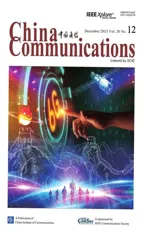Performance Analysis in SWIPT-Based Bidirectional D2D Communications in Cellular Networks
2023-12-10YangZhangWeiWangXiangmoZhaoJunHou
Yang Zhang,Wei Wang,Xiangmo Zhao,Jun Hou
School of Information Engineering,Chang’an University,Xi’an 710064,China
Abstract: In this paper,a novel traffic-aware cooperative cognitive radio network that can enable deviceto-device(D2D)communications in cellular system is proposed and investigated.By providing relay cooperation to cellular transmission,D2D users can realize their own two-way communication in the licensed spectrum.Unlike most existing works,in the proposed network,both wireless-powered D2D users can harvest energy via radio-frequency signals received from basic station (BS) through a hybrid protocol which can adaptively utilize both time-switching and powersplitting techniques.Specifically,D2D users perform decode-and-forward operation to transmit signals,and mobile user(MU)employs a selection combining technique.In addition,the performance of both D2D system and cellular system in the proposed network is evaluated by deriving the expressions of their exact outage probability and throughput.Numerical and simulation results validate correctness of derivations and reveal the influence of various system parameters of the proposed network.
Keywords: D2D communication;outage probability;SWIPT
I.INTRODUCTION
The ever-increasing number of wireless devices poses a huge challenge to the capacity and coverage of cellular networks.However,as a prospective technology in next-generation wireless communication systems,device-to-device(D2D)communication has potential to address this challenge through offloading mobile traffic at base station (BS) and sharing spectrum resources in cellular network[1],[2].D2D communication can establish a direct link between two D2D users by using unlicensed cellular spectrum(outband),or licensed spectrum (in-band) [3].Further,in-band D2D communication can classified into two modes,viz.,overlay mode and underlay mode.In underlay strategy,communications between D2D users is permitted in the licensed spectrum band only when the interference to cellular network is within a certain limit[4],while in overlay strategy,D2D users are allowed to communication while providing relay assistance to cellular transmission[5].In addition,the inband operation is an effective approach to future Internet of Things(IoT)spectrum management by considering the large-scale deployment and quality of service (QoS) for IoT systems in smart cities [6].Thus,we focus on D2D communications overlaying cellular system in this paper,which can meet needs of higher spectrum efficiency (SE) in future IoT communications.
Besides SE,energy efficiency (EE) is another important requirements for future IoT communications[7].As a prospective energy harvesting technology,simultaneous wireless information and power transfer (SWIPT),which can collect energy from radiofrequency signals,is a promising solution to some IoT applications [8],[9].In [10–14],the authors studied the application of SWIPT in relay networks.Specifically,in [10],two energy harvesting relaying strategies,i.e.,power-splitting(PS)relaying and timeswitching (TS) relaying,were introduced.Transmission rate maximization problem for both two protocols were studied in [11].Further,a hybrid relaying protocol which combined TS and PS protocols was analysed [12],[13],and it was proved to have better performance.Recently,an improved hybrid relay protocol considering the direct path between source and destination was proposed,and it outperformed the hybrid protocol in terms of system capacity[14].
Plenty of works have been addressed for SWIPTbased D2D communications on cellular system [15–19].In[15],a matching strategy was proposed,where the EE of the network was maximized by optimizing power splitting and spectrum resource.In [16],a game-theoretic algorithm was proposed to study the question of power allocation in SWIPT-enabled D2D communications in cellular networks.Further,in[17],an energy harvested mode selection method was put forward by considering EE of both D2D and cellular systems.A hybrid relaying strategy was proposed in D2D communications overlaying cellular network,and the outage performance was analysed in [18].Similar model was investigated in [19],where a hybrid energy harvesting algorithm was proposed to optimize outage performance.However,most studies about two-way D2D communications in cellular system are not take the direct path of cellular communication into consideration.Moreover,the hybrid-SWIPT protocol can obviously improve system outage performance.Therefore,different from the aforementioned works,focusing on high system reliability and overall spectrum efficiency,this paper proposes a novel two-way D2D-enabled transmission in cellular network model which integrates the spectrum sharing and SWIPT techniques.Specifically,by applying a hybrid-SWIPT protocol,both two wireless-powered IoDs in the proposed network can harvest energy to decode and forward primary signals to their destination;meanwhile,they can exchange information in the licensed spectrum.Further,the exact expressions of outage probability(OP)and throughput in both cellular and D2D systems are derived,and simulation verify the accuracy of the derivations.Finally,numerical and simulation results reveal the impact of key parameters on system performance.
The paper is structured as follows.Proposed scheme are introduced in Section II.Section III derives the OP and throughput expressions in cellular and D2D systems for the proposed network.Section IV provides simulation and numerical results,and the conclusion is finally presented.
II.SYSTEM MODEL AND PROPOSED SCHEME
Figure 1 presents a SWIPT-based cooperative cognitive radio network,which consists of a mobile user(MU),a basic station (BS),and a pair of IoT devices (IoDs),denoted as IoD1and IoD2.By utilizing a hybrid time-switching/power-splitting scheme,the IoDs can provide relay assistance to the cellular transmission,and,in turn,they can exchange information via the authorized spectrum.The direct path between BS and MU is available.Channel coefficients for links BS-to-MU,BS-to-IoD1,BS-to-IoD2,IoD1-to-IoD2,IoD1-to-MU and IoD2-to-MU are donated ash0,h1,h2,g0,g1,andg2,respectively.Further,it is assumed that all channels follow Rayleigh fading and are reciprocal.Besides,zero-mean andN0variance additive white Gaussian noise(AWGN)is considered in all receiving hops.
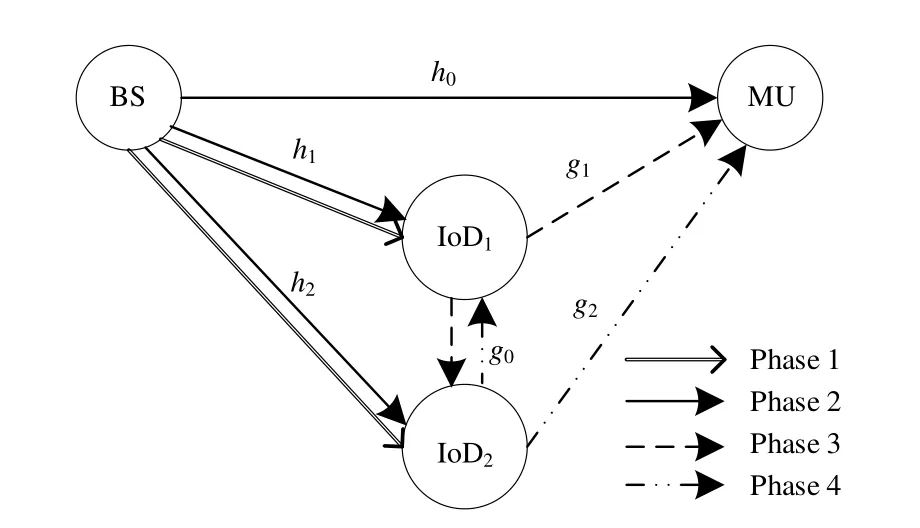
Figure 1.SWIPT-based cooperative cognitive radio network system model.
2.1 Information Processing
In the network,as shown in Figure 2,transmission is performed through four phases.The IoDs harvest energy by receiving the RF signals from BS during the first phaseαT(0<α<1),whereTandαare the transmission block duration and the time allocation ratio,respectively.The harvested energy at IoDiiswhereηiandP0are energy conversion efficiency of IoDiand the transmission power.

Figure 2.Transmission block structure of the proposed network.
In the second phase,the BS broadcasts the primary signalx0to MU and IoDi.Then,the corresponding received signals can be expressed as
The received signal at IoDiused for information processing is
Similarly,in the fourth phase,the signal received at the MU and IoD1are respectively given by
2.2 Instantaneous SNRs and the Achievable Transmission Rate
According to(1)and(4),the SNR at the MU and IoDiin the second phase can be respectively derived as follows,
Here,if the primary signal in the second phase is decoded successfully at IoD2,the interference cancellation(IC)can be used in the third phase to mitigate the influence of the primary signal on the signal received at IoD2.Therefore,in the third phase,the SNR at IoD2without or with the IC operation can be expressed as
Similar to the third phase,in the fourth phase,the instantaneous SNRs at the BS and IoD1can be respectively calculated as
According to (9)-(14),the achievable transmission rates of links BS-to-MU,BS-to-IoD1,BS-to-IoD2,IoD1-to-MU and IoD2-to-MUcan be derived as follows,
Similarly,the achievable transmission rate of the linkwithout or with IC can be written as
III.PROPOSED NETWORK PERFORMANCE EVALUATION
The exact OP expressions of the cellular system and D2D system are derived firstly,then,throughput of the proposed system is calculated by using OP results.
3.1 Outage Probability of Primary System
In the proposed network,MU may receive three copies of the primary signal.The outage event occurs at the BS when its data rate is less than the system target transmission rateR0.Therefore,OP of the cellular system is
In (20),the first term denotes the case where two IoDs can decodex0successfully in the second phase,the middle two terms denote the case where only one of IoDs can successfully decodex0,and the last term means two IoDs fail to decodex0.
Moreover,since MU receives information by employing the selection combining technology,the instantaneous data rate at MU for different cases can be written as follows:
Specifically,the last probability term in (20),PMUPr[RMU<R0],can be expressed as
and the probability termsA1,A2andA3can be respectively rewritten as
Furthermore,B1andB2are given byLemma1.Lemma 1.TheanalyticalexpressionofBiisgivenby Eq.(26),Ψk=Efork∈{0,1,2}.
Proof.On invoking the respective SNRs inBi,it can be rewritten as
Therefore,by applying Maclaurin series expansion and using [20,Eq.(3.381.6)],the analytical expression ofBican be obtained as (26).From the above,the exact OP expressionPout,pof the cellular system can be achieved by substituting(21)-(28)into(20).
3.2 Terminal-to-Terminal OP in D2D System
In addition,by following the similar procedure presented inLemma1,the expression ofC1andC2can be derived in the following two equations:
Therefore,by substituting (21) and the two equations above into (29),the exact OP expressionof link IoDiin the secondary system can be obtained.
3.3 Effective Spectrum Sharing
Considering that BS communicates with MU only via direct path during one transmission block,the OP of the system is represented as
On the other hand,note that spectrum sharing is permissible only when the D2D system does not degrade the cellular system[20].Hence,the OP of cellular system in the proposed network should be no more than that of direct transmission,i.e.,
Therefore,the threshold value (µ*) of power sharing coefficient can be obtained to achieve effective spectrum sharing.Although it seems mathematically intractable to obtainµ*directly from (33),numerical and simulation methods can be adopted to achieve the desired value.
3.4 Outage Probability in D2D System
The OP of the D2D system is defined as the probability that either IoD fails to decodex0or received rate is lower than rate threshold valueRi.Accordingly,OP of D2D system is given by
Further,Jis defined inLemma2.
Lemma 2.TheanalyticalexpressionofJcanbeexpressedas
whereJ1andJ2arerespectivelygivenby(36)and(37).
By applying Maclaurin series expansion and the fact[20,Eq.(3.381.6)],Jcan be rewritten in(36).
By substituting(36)and(37)into(34),the exact OP expression of the D2D system can be achieved.
3.5 System Throughput
As an important performance metric,system throughput is investigated in this subsection to characterize the spectrum utilization.Total system throughput in delay-limited transmission mode is
whereTpandTsrepresent the throughputs of the cellular system and D2D system,respectively.In addition,Tpis formulated by
where the former term represents the case that the primary transmission is executed with relay cooperation,and the latter term donates the case that the cellular transmission is implemented only via the direct path.By substituting(20),(21),and(22)into(40),the cellular system throughput can be obtained.
Besides,Tscan be expressed as
wherePout,ifori∈{1,2}is given by(29).Therefore,by substituting(40)and(41)into(39),the desired system throughput can be achieved.
IV.NUMERICAL AND SIMULATION RESULTS
Figure 3 investigates the relationship between the SNR and the OP of the cellular system with various target rate and power-sharing factors.The other parameters are set as follows:α=0.2,ρ1=ρ2=0.5 andη1=η2=0.7.Note that all the analytical curves and the simulation results are perfectly matched in this figure,which validates the correctness of the derivation in the cellular OP.As shown in Figure 3,the cellular OP decreases as the target rate decreases from 1/3 to 1/9 bps/Hz.Furthermore,the cellular OP also reduces with the increasing of the power sharing factorµi,which can be explained by the fact that the largerµi,the more power is allocated to the primary signal transmission.
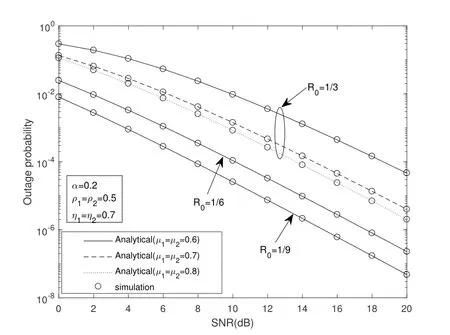
Figure 3.The OP versus SNR of the cellular system under various target rates and power-sharing factors.
Figure 4 shows outage performance under various SNR of the D2D system.The target rate atIoD1andIoD2in this figure are set asR1=R2=R0,while the other parameters are the same as those in Figure 3.Note that the analysis curves and simulation results are also consistent in the figure.Similar to the results presented in Figure 3,the D2D OP in Figure 4 declines with the reducing of the target rate.On the other hand,when the power sharing factor increases,less power is allocated for D2D signal,which,in turn,increases the D2D OP.
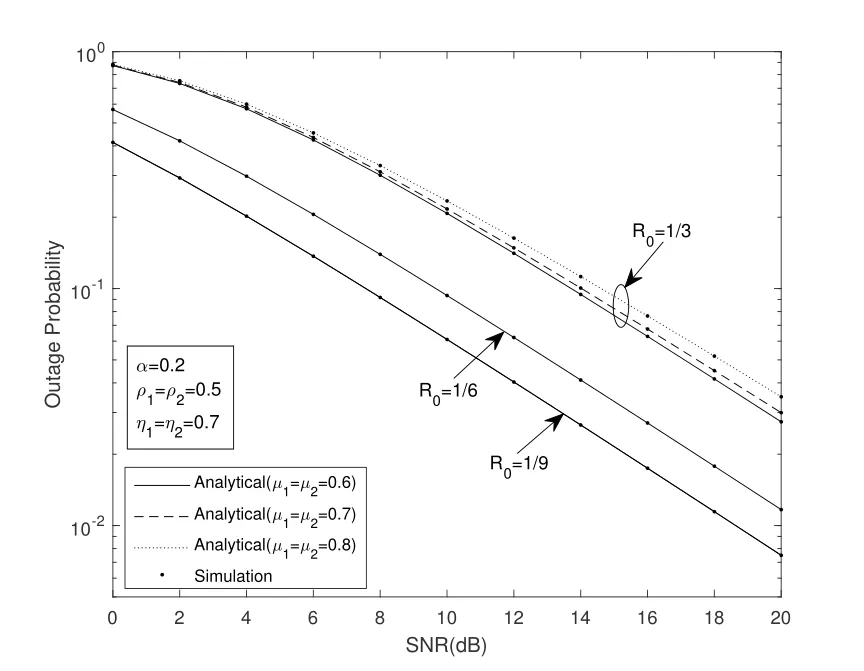
Figure 4.The OP performance under various SNRs and target rates of the D2D system.
The OP versusµvalue under the cellular and D2D systems are shown in Figures 5 and 6,respectively.The parameters are set as follows:α=0.2,ρ1=ρ2=0.5,η1=η2=0.7,and=15 dB.In Figure 5,the cellular OP decreases sharply whenµreached a certain value,which can be explained byLemma1: The improvement of reliability occurs whenµ>γ0(1-µ).Besides,the threshold valueµ*can be obtained through a numerical method.It can achieve the same OP value for the proposed cellular system and the direct transmission system.Note that spectrum sharing is effective whenµ*<µ,and the largerR0is,the lowerµ*is.While unlike the trend presented in Figure 5,the OP of the proposed D2D system in Figure 6 increases with the increasing of power allocation factor in the entire range ofµ.
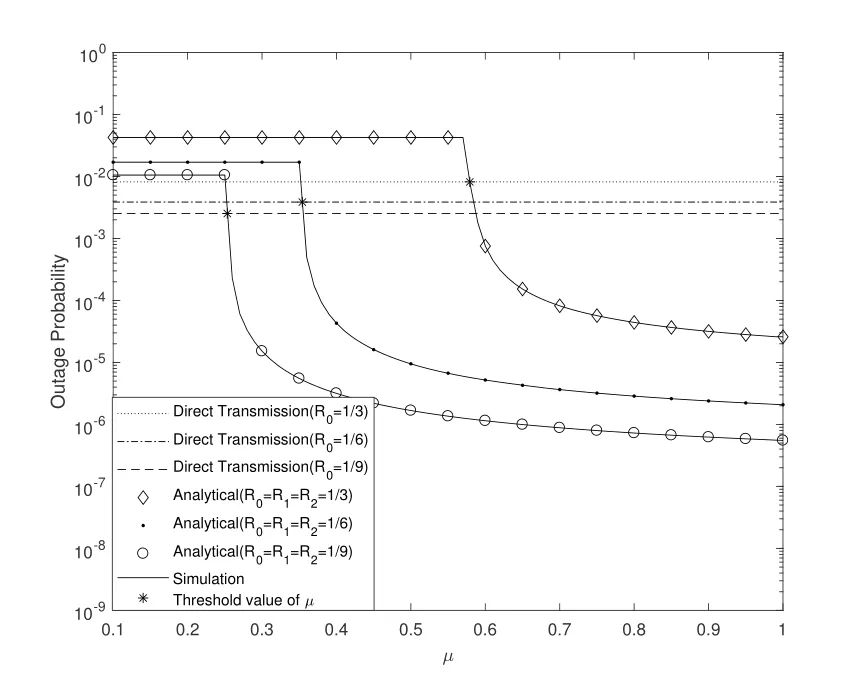
Figure 5.The OP versus the power-sharing factorµvalue under the cellular system.
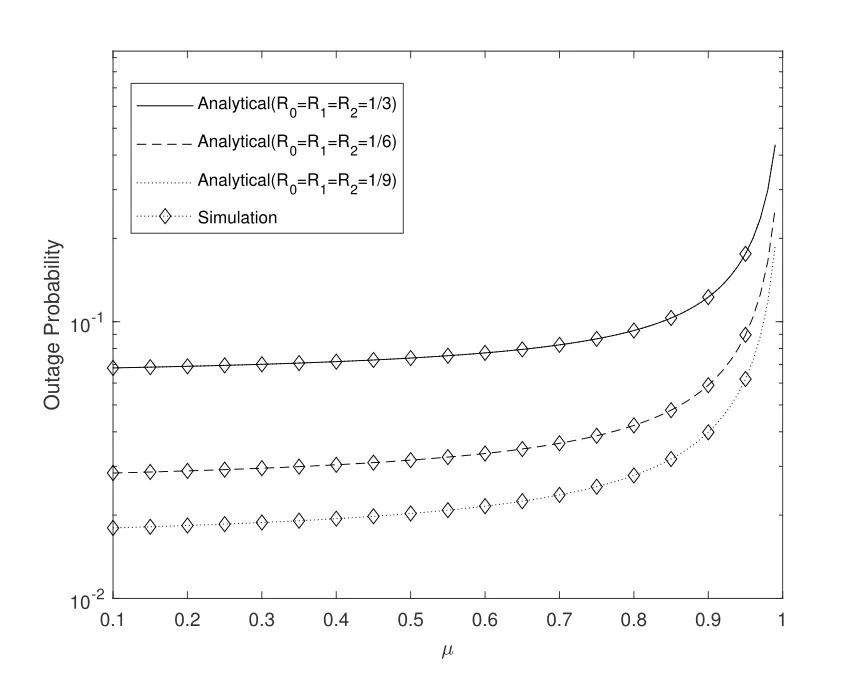
Figure 6.The OP versus the power-sharing factorµvalue under the D2D system.
Figure 7 represents the OP versusµifor terminalto-terminal links of the D2D system.Obviously,it can be noticed that the OP sharply increases whenµis greater than a certain value,which can be explained byLemma2: The transmission reliability atincreases when 1-
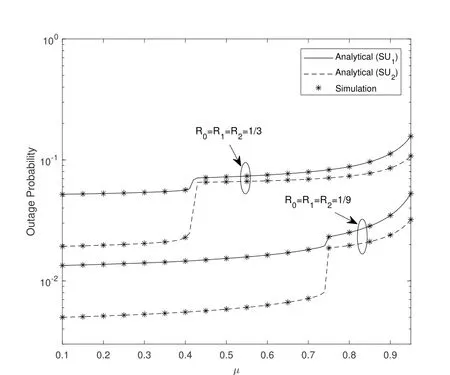
Figure 7.The OP versusµfor terminal-to-terminal links of the D2D system.
Figures 8 and 9 depict the influences of the TS factorαand the PS factorρon cellular OP and D2D OP,respectively.Parameters are set as follows:µ1=µ2=0.8,η1=η2=0.7,R0=R1=R2=1/3 and=10 dB.As shown in Figure 8,the minimum cellular OP can be achieved whenα=0.04 andρ=0.62.This can be explained that for a smallαand a nearly largeρ,the primary signal transmission has longer transmission time and larger transmit power.On the other hand,in Figure 9,the minimum D2D OP is obtained whenα=0.28 andρ=0.18.Therefore,one can choose suitableαandρby means of considering cellular OP and D2D OP together.
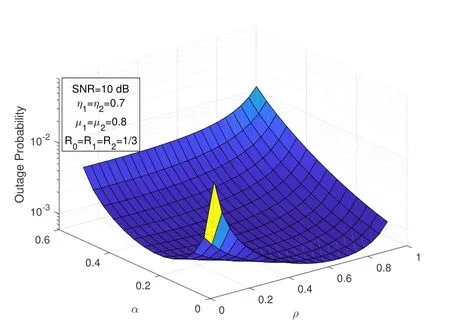
Figure 8.The influence of different α and ρ on cellular OP.
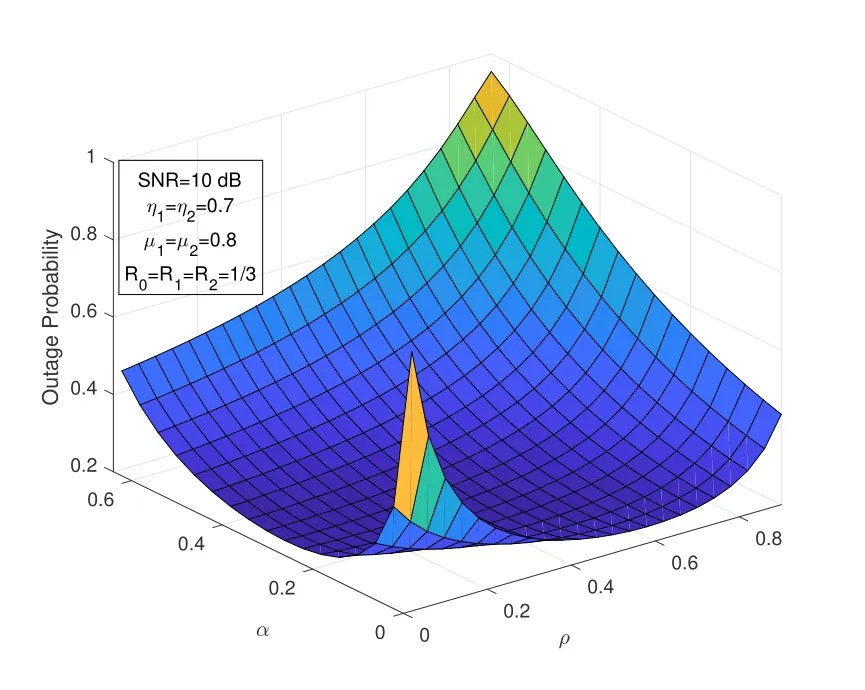
Figure 9.The influence of different α and ρ on D2D OP.
Figure 10 plots the curves of the average system throughput versus SNR.Here,we setµ1=µ2=0.7.As shown,the system throughput performance improves as the SNR increases because the higher SNR improves the OP performance.Besides,in the midto-high SNR region,the larger the target rate,the higher system OP,and the impact of OP on the system throughput is less than that of the target rate.Therefore,the system throughput increases with target rate.Furthermore,when the SNR is large enough,the throughput converges to a fixed value of(1-α)R0,that is,the maximum achievable system throughput.
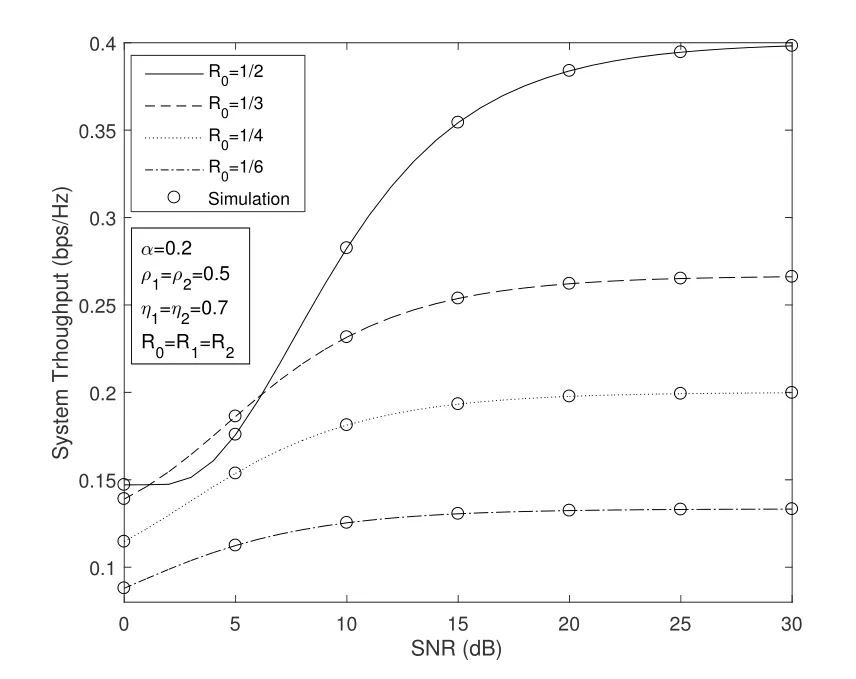
Figure 10.The average system throughput versus SNR.
V.CONCLUSION
This paper proposed a hybrid-SWIPT cooperative cognitive radio network to improve reliability of cellular transmission and to enable bidirectional D2D communication in the authorized spectrum.It is shown that D2D users can be as relays to help cellular transmission by performing the decode-and-forward operation.To evaluate the proposed system performance,the expressions of exact outage probability and throughput in both cellular system and D2D system are derived.The condition for effective spectrum sharing is also investigated.The proposed scheme can maximum the system outage performance by choosing appropriate time allocation factor and power splitting factor.Further,Analytical and simulation results reveal the influence of important parameters on system reliability.
ACKNOWLEDGEMENT
This work was supported by the Postdoctoral Research Project of Shaanxi Province under Grant 2023BSHEDZZ215.
杂志排行
China Communications的其它文章
- Spatial Modeling and Reliability Analyzing of Reconfigurable Intelligent Surfaces-Assisted Fog-RAN with Repulsion
- An Efficient Federated Learning Framework Deployed in Resource-Constrained IoV:User Selection and Learning Time Optimization Schemes
- ELM-Based Impact Analysis of Meteorological Parameters on the Radio Transmission of X-Band over the Qiongzhou Strait of China
- IoV and Blockchain-Enabled Driving Guidance Strategy in Complex Traffic Environment
- Multi-Source Underwater DOA Estimation Using PSO-BP Neural Network Based on High-Order Cumulant Optimization
- Secure Short-Packet Transmission in Uplink Massive MU-MIMO Assisted URLLC Under Imperfect CSI
